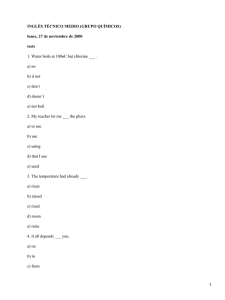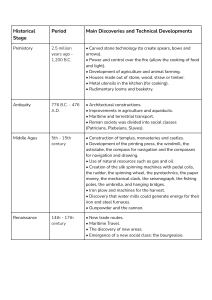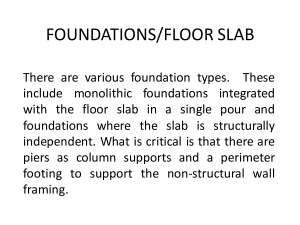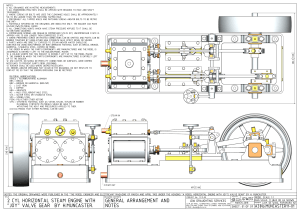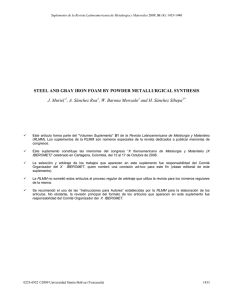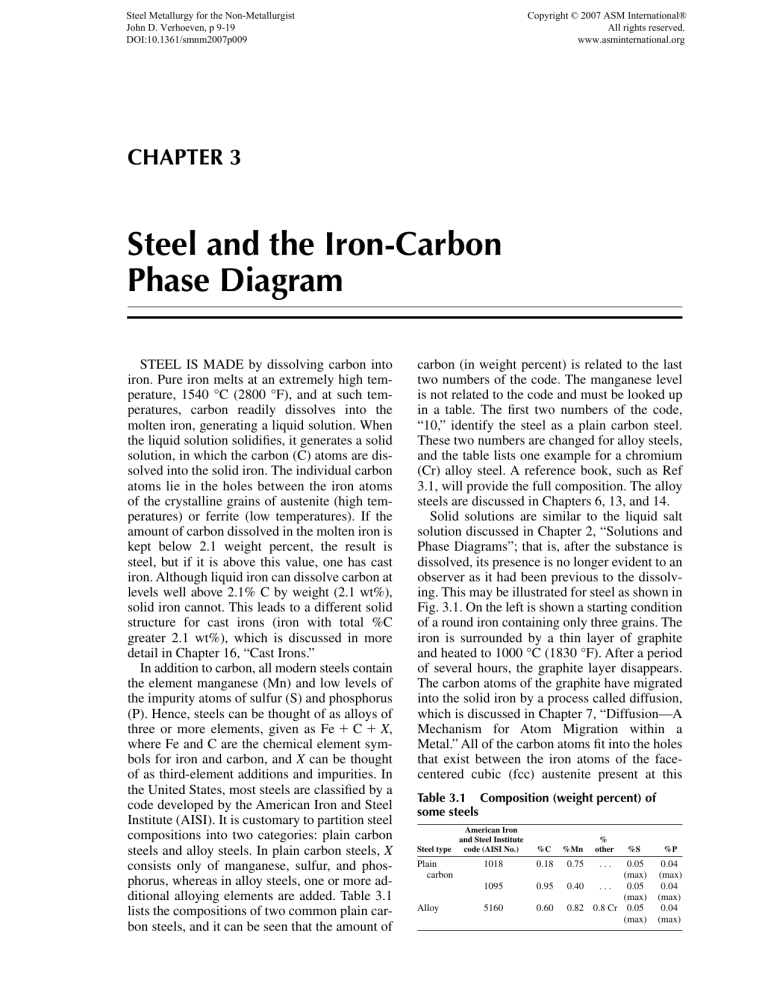
Steel Metallurgy for the Non-Metallurgist John D. Verhoeven, p 9-19 DOI:10.1361/smnm2007p009 Copyright © 2007 ASM International® All rights reserved. www.asminternational.org CHAPTER 3 Steel and the Iron-Carbon Phase Diagram STEEL IS MADE by dissolving carbon into iron. Pure iron melts at an extremely high temperature, 1540 °C (2800 °F), and at such temperatures, carbon readily dissolves into the molten iron, generating a liquid solution. When the liquid solution solidifies, it generates a solid solution, in which the carbon (C) atoms are dissolved into the solid iron. The individual carbon atoms lie in the holes between the iron atoms of the crystalline grains of austenite (high temperatures) or ferrite (low temperatures). If the amount of carbon dissolved in the molten iron is kept below 2.1 weight percent, the result is steel, but if it is above this value, one has cast iron. Although liquid iron can dissolve carbon at levels well above 2.1% C by weight (2.1 wt%), solid iron cannot. This leads to a different solid structure for cast irons (iron with total %C greater 2.1 wt%), which is discussed in more detail in Chapter 16, “Cast Irons.” In addition to carbon, all modern steels contain the element manganese (Mn) and low levels of the impurity atoms of sulfur (S) and phosphorus (P). Hence, steels can be thought of as alloys of three or more elements, given as Fe ⫹ C ⫹ X, where Fe and C are the chemical element symbols for iron and carbon, and X can be thought of as third-element additions and impurities. In the United States, most steels are classified by a code developed by the American Iron and Steel Institute (AISI). It is customary to partition steel compositions into two categories: plain carbon steels and alloy steels. In plain carbon steels, X consists only of manganese, sulfur, and phosphorus, whereas in alloy steels, one or more additional alloying elements are added. Table 3.1 lists the compositions of two common plain carbon steels, and it can be seen that the amount of carbon (in weight percent) is related to the last two numbers of the code. The manganese level is not related to the code and must be looked up in a table. The first two numbers of the code, “10,” identify the steel as a plain carbon steel. These two numbers are changed for alloy steels, and the table lists one example for a chromium (Cr) alloy steel. A reference book, such as Ref 3.1, will provide the full composition. The alloy steels are discussed in Chapters 6, 13, and 14. Solid solutions are similar to the liquid salt solution discussed in Chapter 2, “Solutions and Phase Diagrams”; that is, after the substance is dissolved, its presence is no longer evident to an observer as it had been previous to the dissolving. This may be illustrated for steel as shown in Fig. 3.1. On the left is shown a starting condition of a round iron containing only three grains. The iron is surrounded by a thin layer of graphite and heated to 1000 °C (1830 °F). After a period of several hours, the graphite layer disappears. The carbon atoms of the graphite have migrated into the solid iron by a process called diffusion, which is discussed in Chapter 7, “Diffusion—A Mechanism for Atom Migration within a Metal.” All of the carbon atoms fit into the holes that exist between the iron atoms of the facecentered cubic (fcc) austenite present at this Table 3.1 Composition (weight percent) of some steels American Iron and Steel Institute Steel type code (AISI No.) Plain carbon Alloy %C %Mn % other 1018 0.18 0.75 ... 1095 0.95 5160 0.60 %S 0.05 (max) 0.40 ... 0.05 (max) 0.82 0.8 Cr 0.05 (max) %P 0.04 (max) 0.04 (max) 0.04 (max) 10 / Steel Metallurgy for the Non-Metallurgist temperature. This solid solution of carbon in iron is steel. Figure 1.4 locates the center of the iron atoms in the fcc lattice. If each of the little solid dots of Fig. 1.4 are allowed to expand until they touch each other, the result is the model of fcc iron shown in Fig. 3.2. The expanded iron atoms touch each other along the face diagonals of the cube. The small open circles locate the center of the void spaces between the iron atoms. If these small circles are expanded until they touch the iron atoms, their maximum diameter will equal 41.4% of the iron atom diameter. This means that atoms smaller than approximately 42% of the iron atom diameter should fit into the holes between the iron atoms. Carbon atoms are small, but the diameter of carbon atoms is estimated to be 56% of the diameter of iron atoms in austenite. Hence, when carbon dissolves in iron, it pushes the iron atoms apart a small amount. The more carbon dissolved, the further the iron atoms are pushed apart. Thus, there is a limit to how much carbon can dissolve in iron. In pure iron, the difference in ferrite and austenite is a difference in their atomic structures. As illustrated in Fig. 1.2 and 1.4, the iron atoms are arranged with a body-centered cubic (bcc) crystal structure in ferrite and an fcc crystal structure in austenite. In both ferrite grains and austenite grains, this atomic structure does not change within the grain. Thus, similar to the ice and water example in Chapter 2, both ferrite and austenite are individual phases. When carbon is added to austenite to form a solid solution, as illustrated in Fig. 3.1, the solid solution has the same fcc crystal structure as in pure iron. As discussed with reference to Fig. 3.2, the carbon from the graphite just fits in between the iron atoms. The crystal structure remains fcc, the only change being that the iron atoms are pushed very slightly farther apart. Both pure austenite and austenite with carbon dissolved in it are the same phase. Thus, austenite with carbon dissolved in it and ferrite with carbon dissolved in it are two different phases, both of which are steel. Low-Carbon Steels (Hypoeutectoid Steels) The iron-carbon phase diagram provides a temperature-composition map of where the two phases, austenite and ferrite, will occur. It also indicates where mixtures of these two phases can be expected, just like the slush region on the icesalt phase diagram. A portion of the iron-carbon phase diagram is shown in Fig. 3.3, and it is seen that there is a strong similarity to the salt diagram of Fig. 2.2. In pure iron, austenite transforms to ferrite on cooling to 912 °C (1674 °F). This transition temperature is traditionally called the A3 temperature, and the diagram shows that, just as adding salt to water lowers the freezing point of water, adding carbon to iron lowers the A3 temperature. Whereas the maximum lowering HISTORICAL NOTE The iron age dates to approximately 1000 B.C., when our ancestors first learned to reduce the plentiful iron oxide ores found on earth into elemental iron. The iron was made in furnaces that were heated by charcoal fires that were not able to get hot enough to melt the iron. They produced an iron called bloomery iron, which is similar to modern wrought iron. Even though charcoal was used in these furnaces, very little carbon became dissolved in the iron. So, to make steel, carbon had to be added to the bloomery iron. (Even to this day, steel cannot be economically made directly from the iron ore. The modern two-step process first makes high-carbon pig iron, and the second step reduces the carbon composition to the steel range.) Our ancestors did not know the nature of the element carbon until approximately 1780 to 1790 A.D., and steel and cast iron played a key role in its discovery. Until shortly before that time, the production of steel was primarily the result of blacksmiths heating bloomery iron in charcoal fires. This process is tricky because a charcoal fire can just as easily remove carbon as add it (Chapter 7, "Diffusion— A Mechanism for Atom Migration within a Metal"). Therefore, steel was made on a hitand-miss basis from the start of the iron age, and the quality of such steel varied widely. The successful blacksmiths guarded their methods carefully. Chapter 3: Steel and the Iron-Carbon Phase Diagram / 11 occurs at what is called the eutectic point in water-salt, a similar maximum lowering occurs in iron-carbon, but here it is called the eutectoid point and also the pearlite point. The eutectoid point represents the temperature and composition on the phase diagram where a eutectoid reaction occurs, that is, a reaction where one solid transforms into two solids. The eutectoid point in the iron-carbon system has a composition of 0.77% C, and steels with compositions less than this value are called hypoeutectoid steels. The eutectoid temperature is traditionally called the A1 temperature. Steels that are 100% austenite must have temperature-composition coordinates within the upper central dark area of Fig. 3.3. Steels that are ferrite must have temperature-composition Fig. 3.1 Converting a rod of iron containing only three grains to steel by dissolving carbon in it coordinates in the skinny dark region at the left side of Fig. 3.3. The maximum amount of carbon that will dissolve into ferritic iron is only 0.02%, which occurs at the eutectoid temperature of 727 °C (1340 °F). This means that ferrite is essentially pure iron, because it is always Fig. 3.2 Location of iron atoms in face-centered cubic austenite. Small circles locate the centers of holes between the iron atoms Fig. 3.3 Portion of iron-carbon phase diagram for hypoeutectoid steel alloys (%C less than 0.77) 12 / Steel Metallurgy for the Non-Metallurgist 99.98% or purer with respect to carbon. Notice, however, that austenite may dissolve much more carbon than ferrite. At the eutectoid temperature, austenite dissolves 0.77% C, which is roughly 38 times more carbon than ferrite will hold at this temperature. Austenite holds more carbon than ferrite, because the holes between iron atoms are larger in the fcc structure than the bcc structure. Remember that in the salt-water phase diagram, the shaded slush region mapped the temperature-composition points where one obtains slush, a mixture of water and ice. Similarly, the central shaded region of Fig. 3.3 labeled α ⫹ γ maps temperature-composition points where steel consists of a mixture of ferrite and austenite. Suppose a hot stage microscope is used to look at a polished steel having a composition of 0.4% C after it had been heated to 760 °C (1400 °F). Because this temperature-composition point lies in the central shaded region labeled α ⫹ γ, the steel must be a mixture of ferrite and austenite, an example of which is shown at the bottom of Fig. 3.3. The phase diagram also gives information about the composition of the two phases. The austenite grains must have the composition given as N and the ferrite the composition given as M in Fig. 3.3. As a further illustration of the usefulness of the phase diagram, consider the following simple experiment. A steel of composition 0.4% C is first heated to 850 °C (1560 °F) and held for approximately 10 min. After this short hold, all the grains in this steel would consist of pure fcc austenite grains with a composition of 0.4% C. To make the illustration simple, imagine looking at the steel in a hot stage microscope and seeing a region of only three grains, as shown in Fig. 3.4. Now, imagine the hot stage temperature is reduced to 760 °C (1400 °F), and the sample slowly cools to this temperature. What happens to the microstructure? According to the phase diagram, the steel, after cooling, must become two phases, a mixture of austenite and ferrite. Experiments show that the ferrite that forms in the pure austenite as it cools virtually always forms on the austenite grain boundaries. This is illustrated in the lower microstructure of Fig. 3.4, where the ferrite has formed as a number of α grains along the prior-austenite grain boundaries. Comparing the microstructure at the right side of Fig. 3.4 to that at the bottom of Fig. 3.3 reveals similarities and differences. They are similar in that both contain a mixture of ferrite and austenite grains with the same volume fraction of each, but they are different in that the distribution of the ferrite grains is quite different. The microstructure of Fig. 3.3 will generally be formed on heating the steel from room temperature to 760 °C (1400 °F). Thus, this example illustrates one of the fascinating aspects of steels: the microstructure is controlled by heat Fig. 3.4 Portion of iron-carbon phase diagram and change in microstructure on cooling a 1040 steel from 850 to 760 °C (1560 to 1400 °F) Chapter 3: Steel and the Iron-Carbon Phase Diagram / 13 treatment. As is shown later, the mechanical properties of steels are controlled by microstructure. The microstructure of a steel generally refers to the specific shape, size, distribution, and phase types of the grains in the steel. Remember, the phases present in Fig. 3.3 and 3.4 are only present at the high temperature of 760 °C (1400 °F), not at room temperature. Roomtemperature phases are discussed later. High-Carbon Steels (Hypereutectoid Steels) As the %C dissolved in austenite increases, the iron atoms are pushed further apart. This stretches the chemical bonds that hold the iron atoms together, generating a form of energy called strain energy. There is a limit to how much strain energy the austenite can stand. The amount of carbon dissolved in austenite when this limit is reached is called the solubility limit. Question: The solubility limit in austenite at 820 °C (1508 °F) is 1 wt% C. If an alloy containing 1.5 wt% C is heated to 820 °C (1508 °F), only 1% of this 1.5% C will be dissolved in the austenite. What happens to the remaining 0.5% C? This excess carbon becomes incorporated into a new phase called cementite. The new phase, cementite, has one major difference from austenite or ferrite. It is a chemical compound that exists at only one composition. Chemical compounds are generally represented by their elemental formulas, such as NaCl for sodium chloride table salt. The composition for NaCl is 50 atomic percent sodium, which corresponds to 39.3 weight percent sodium. The chemical element formula for cementite is Fe3C. For each atom of carbon in the compound, there are three atoms of iron, giving an atomic composition of 25 at.% C. The corresponding weight percent carbon in cementite is 6.7 wt% C. Other than this limitation to one composition, cementite has several similarities to austenite and ferrite. It is a crystal having its atoms arranged in regularly repeating geometrical arrays. The crystal structure is a little more complex than either the bcc of ferrite or the fcc of austenite, but it is well known. Also, it is a separate phase and is present as discrete grains. So, all the excess 0.5% C in this example at 820 °C (1508 °F) will be present as separate cementite grains mixed in with the austenite grains; that is, the microstructure will be a two-phase mixture of austenite and cementite. The iron-carbon phase diagram extended to higher-carbon compositions where cementite becomes important is shown in Fig. 3.5. As before, the region on the temperature-composition map corresponding to austenite is shown as the central dark region. Because cementite exists at only one composition, it is shown on the phase Fig. 3.5 Extension of the iron-carbon phase diagram to hypereutectoid steel alloys (%C greater than 0.77) 14 / Steel Metallurgy for the Non-Metallurgist diagram as a vertical line located at its composition, 6.7% C. Notice that the composition axis at the bottom of the diagram has a break in it just beyond 1.2%, and the value of 6.7% is located next to the break. If the break were not inserted, the 6.7% composition would appear roughly one foot to the right. To envision the true diagram, imagine extending the right portion approximately one foot, which expands the shaded two-phase region labeled γ ⫹ cm into a much larger area. The line on the diagram labeled Acm defines the solubility limit for carbon in austenite. Notice that at 820 °C (1508 °F), this line gives a point at 1 wt% C, which is the maximum amount of carbon that can be dissolved in austenite at 820 °C (1508 °F). Alloys having %C compositions to the right of the Acm line are in the shaded twophase region labeled γ ⫹ cm and must consist of a mixture of austenite and cementite grains. For example, consider a 1095 steel (0.95 wt% C) received from a steel mill. If this steel is heated to 760 °C (1400 °F), the temperature-composition point will be at the open circle in Fig. 3.5 with the horizontal arrowed line passing through it. Because the temperature-composition point lies in the shaded two-phase region labeled γ ⫹ cm, this steel must consist of a mixture of austenite having composition O (0.85% C) and cementite of composition P (6.7% C). The diagram does not describe what the microstructure will look like; however, experiments show that the microstructure will be as illustrated at the bottom of Fig. 3.5. All of the cementite appears as small, spherically shaped grains distributed fairly randomly over the austenite grains, which have much larger sizes and the typical curved grain boundaries. To further illustrate the use of the phase diagram in understanding how microstructure changes during heat treatment, consider an experiment where the as-received 1095 steel is heated to 850 °C (1560 °F) and held for 20 min or so. As shown on the phase diagram of Fig. 3.6, this temperature-composition point corresponds to the single-phase austenite region. Assuming the structure could be observed in a hot stage microscope, the small region under observation at high magnification may consist of just three grains, which would have an appearance similar to that shown in Fig. 3.6. If the temperature of the hot stage is lowered to 760 °C (1400 °F), then this temperature-composition point lies in the two-phase austenite ⫹ cementite region, which means that cementite grains must form on cooling. Just as is the case for the hypoeutectoid steel of Fig. 3.3, where ferrite forms on the austenite grain boundaries during cooling, here cementite forms on the austenite grain boundaries during cooling. As shown in Fig. 3.6, Fig. 3.6 Portion of iron-carbon phase diagram and change in microstructure on cooling a 1095 steel from 860 to 760 °C (1580 to 1400 °F) Chapter 3: Steel and the Iron-Carbon Phase Diagram / 15 the final microstructure has all of the prioraustenite grain boundaries from the 850 °C (1560 °F) structure filled with thin, plateshaped grains of cementite. Notice the dramatic difference in this microstructure from that shown in Fig. 3.5, where the 1095 steel was heated directly from room temperature to 760 °C (1400 °F). Both microstructures contain the same volume fraction of cementite and austenite, but the distribution of the cementite is quite different. Unlike austenite and ferrite, cementite is very brittle. Consequently, the 1095 structure of Fig. 3.6 with its interconnected cementite plates is not as tough as the Fig. 3.5 structure with its small, isolated cementite grains. Again, this is an example of how heat treatment can change microstructure, which, in turn, changes mechanical properties. Eutectoid Steel (Pearlite) In the previous two sections, steels having compositions on either side of the eutectoid composition of 0.77 wt% C were considered. Steels having the composition of 0.77% C (a 1077 steel) generate a unique microstructure called pearlite. Figure 3.7 presents the ironcarbon phase diagram on which the area below the A1 line of 727 °C (1340 °F) is shaded dark. This entire area is a two-phase region. Any steel cooled slowly into the temperature-composition coordinates of this area must consist of a mixture of the two phases, ferrite and cementite (α ⫹ Cm). The microstructures of steels in this two-phase region vary widely, and pearlite is just one of many microstructures that can occur. To understand the pearlite microstructure, consider a 1077 steel that is heated in a hot stage microscope to 800 °C (1470 °F). As shown in Fig. 3.7, the steel will consist of all austenite grains after just a minute or two at 800 °C. After cooling to a temperature below A1 and holding for 5 to 10 min or so, the austenite grains will be completely replaced by a new set of pearlite grains, as shown in the figure. Contrary to all the grain structures discussed up to this point, the pearlite grains are not a single phase. Rather, they consist of a mixture of two phases, ferrite and cementite (α ⫹ Cm), having a unique microstructure. To observe the true details of the microstructure, a small region within a pearlite grain must be observed under very high magnification, as shown in the lower right of Fig. 3.7. The structure consists of alternating plates of ferrite and cementite. The ferrite plates are much fatter than the cementite plates, occupying 90% of the volume compared to only 10% for the cementite. At the pearlite grain boundaries, there is an abrupt change in the orientation Fig. 3.7 Portion of iron-carbon phase diagram and formation of the pearlite microstructure on cooling a 1077 steel below the A1 temperature of 727 °C (1340 °F) 16 / Steel Metallurgy for the Non-Metallurgist cooling), the austenite will transform into some form of ferrite ⫹ cementite. The A1, A e , A c , and Ar1 1 1 Nomenclature Fig. 3.8 Electron microscope image of pearlite after polish- ing and etching in nital. Original magnification: 11,000 ×. Source: Ref 3.2 of the plates, as is shown for a real sample in Fig. 3.8, which is a transmission electron microscope picture at a magnification of 11,000 times. In this picture, the cementite plates are the light phase and the ferrite plates are the dark phase. (Note that the cementite plates are only 0.1 μm, or 4 × 10⫺6 in., thick, too thin to be resolved on an optical microscope. Although cementite is brittle, pearlite is not, due largely to the fine size of the cementite plates.) If the 1077 steel is now cooled from the 700 °C (1300 °F) temperature shown in Fig. 3.7 to room temperature, the microstructure will not change significantly, no matter how slow or fast the sample is cooled. The ferrite will remain a nearly pure bcc iron with less than 0.02% C dissolved in it, and the cementite will remain at 6.7% C with an unchanged crystal structure. According to the phase diagram, when austenite is cooled below the A1 temperature and held for a short period, the austenite will be completely replaced by some form of ferrite ⫹ cementite, and on cooling to room temperature, no further changes in the resulting ferrite ⫹ cementite microstructure will occur. Austenite is never seen in plain carbon steels at room temperature. (An exception to this rule is quenched high-carbon steels, which contain mixtures of martensite and retained austenite.) This means that microstructures containing austenite, such as those shown in Fig. 3.2 to 3.5, can only be seen in a hot stage microscope, because the austenite will be replaced by other structures on cooling. At high cooling rates (such as obtained in water and oil quenching), these include the martensite and bainite structures discussed subsequently. At air cooling rates and slower (such as furnace The iron-carbon phase diagram shown in the previous figures is called an equilibrium phase diagram. This means that the transformation temperatures given by the A lines were determined at extremely slow cooling or heating rates, where equilibrium conditions are obtained. The A3, Acm, and A1 lines that appear on equilibrium phase diagrams are often labeled the A e3, A ecm, and A e lines, respectively, where the “e” 1 indicates equilibrium conditions. In this book, the “e” will generally not be used. The absence of the “e” implies equilibrium conditions. Consider again the experiment illustrated in Fig. 3.7. The diagram predicts that when the austenite grains cool to 727 °C (1340 °F), pearlite will start to form from the austenite. This only occurs if the austenite is cooled extremely slowly. At even modest cooling rates such as 3 °C/min (5 °F/min), the transformation temperature is lowered by approximately 20 °C (36 °F). This means that the iron-carbon diagram can only be used as a rough guide for estimating transformation temperatures. Not only is the transformation from austenite to pearlite on cooling shifted down in temperature, the reverse transformation from pearlite to austenite on heating is shifted up in temperature. A simple experiment was run to demonstrate the magnitude of this shift on cooling and heating and how it can be measured. A hole was drilled in a small piece of 1018 steel and a thermocouple secured in the hole. The output of the thermocouple was measured with a digital voltmeter every 2 s and sent to a computer, where it was converted to a file of temperature versus time. The sample was placed in a small resistance furnace and heated to 870 °C (1600 °F) and then removed from the furnace. The output of the thermocouple for both the heating and cooling cycle is shown in Fig. 3.9 and 3.10, respectively. As explained in Chapter 1, “Pure Iron,” when austenite changes to ferrite on cooling, heat is liberated, and when ferrite changes to austenite on heating, heat is absorbed. Consider first the heating curve of Fig. 3.9. As is discussed in Chapters 5 and 7, the A3 and the A1 lines of the Chapter 3: Steel and the Iron-Carbon Phase Diagram / 17 HISTORICAL NOTE The same French scientist, Floris Osmond, who is responsible for the name of martensite is also responsible for the use of the letters "r" and "c" for the shift in the A lines on cooling and heating. At the end of the 19th century, he was the first scientist to use thermocouples to measure the effect of heating and cooling rates. The letter "r" is from the French word for cooling, refroidissement, and the letter "c" is from the French word for heating, chauffage. Fig. 3.9 Heating (chauffage) curve for a 1018 steel pure iron-carbon diagram are shifted down in temperature by the 0.75% Mn and 0.2% Si present in 1018 steel to the values of A1 ⫽ 725 °C (1337 °F) and A3 ⫽ 824 °C (1515 °F). The heating data of Fig. 3.9 show that at approximately 737 °C (1359 °F), the rate of temperature rise abruptly decreases. This is due to the heat absorbed by the sample as the pearlite part of the steel transforms to austenite. It means that the A1 line has shifted up by 12 °C (25 °F), from 725 to 737 °C (1337 to 1359 °F). It is customary to label the actual temperature of the transformation on heating as A c , as shown in the figure. 1 The amount of the upward shift depends on the heating rate. If the heating rate were increased above the value of 40 °C/min (72 °F/min), the value of A c would increase. 1 On cooling, an opposite effect occurs: the heat liberated when austenite transforms to ferrite or pearlite slows down the rate of decrease in the sample temperature. Figure 3.10 illustrates this effect for both the austenite ⇒ ferrite transformation below the A3 temperature and the austenite ⇒ pearlite transformation below the A1 temperature. The former transformation begins to occur at 762 °C (1404 °F), which is 62 °C (110 °F) below the A3 temperature of 824 °C (1515 °F), and the latter occurs at 652 °C (1206 °F), which is 73 °C (130 °F) below the A1 temperature of 725 °C (1337 °F). As shown in Fig. 3.10, it is customary to label the actual transformation temperatures that occur on cooling as the A r and A r tempera3 1 tures. Notice that the cooling rate for the data of Fig. 3.10 is three times larger than the heating rate for the data of Fig. 3.10. This larger rate accounts for the increased shift in the A1 temperature from ⫺73 °C (⫺130 °F) on cooling to only ⫹ 12 °C (22 °F) on heating. (The temperature range of Fig. 3.9 did not extend high enough to measure the increased A3 temperature, which is called the A c temperature.) 3 Figure 3.11 presents a graphical summary of the aforementioned ideas, showing the shift up of the A lines on heating, with labels having subscript “c” added, and the shift down on cooling, with the labels have the subscript “r” added. These shifts in transformation temperatures can become important in manufacturing operations involving rapid heating and cooling. An example is the shift up in transformation temperature with heating in processes such as flame and induction hardening. Summary of the Major Ideas in Chapter 3 1. In the United States, steels are specified with the American Iron and Steel Institute (AISI) code. As shown in Table 3.1, the code tells the carbon composition and whether the steel is an alloy steel or a plain 18 / Steel Metallurgy for the Non-Metallurgist Fig. 3.10 Cooling (refroidissement) curve for a 1018 steel Fig. 3.11 Nomenclature for the A lines shifted up on heating and down on cooling carbon steel. A reference, such as Ref 3.1, should be consulted to determine the full composition. 2. Steel is made by adding carbon to iron, and the main structures are ferrite and austenite, the same as those of pure iron discussed in Chapter 1. At low-carbon compositions, the carbon is dissolved into the iron, forming solid solutions of ferrite (body-centered cubic, bcc) at low temperatures and austenite (face-centered cubic, fcc) at high temperatures. At high-carbon compositions, a compound of carbon with iron, cementite, or Fe3C, forms in the steel. These three structures are called phases, and the ironcarbon phase diagram maps the temperature-composition values where the three different phases are stable. 3. The iron-carbon phase diagram is similar to the salt-water phase diagram of Chapter 2. As carbon is added, the austenite-to-ferrite transformation drops from the 912 °C (1674 °F) value of pure iron and attains a minimum value at 727 °C (1340 °F). Beyond the minimum, the transformation temperature increases, and cementite begins to form. The minimum occurs at a composition of 0.77% C, which is called the eutectoid point. 4. It is common to classify steels with carbon compositions less than the eutectoid value as hypoeutectoid steels and those with more than 0.77% C as hypereutectoid steels. 5. As a hypoeutectoid steel cools from the austenite region, grains of ferrite will begin to form on the old austenite grain boundaries. At any specific temperature below that at which ferrite starts to form and above the eutectoid temperature, the phase diagram allows the calculation of the volume fraction of ferrite formed and the composition of both the ferrite formed and the remaining austenite. 6. The microstructure of a steel refers to the size, shape, and distribution of the phases that make up the steel. The microstructure is Chapter 3: Steel and the Iron-Carbon Phase Diagram / 19 controlled by the history of the steel, that is, how it was heated and cooled and any prior mechanical deformation. 7. As a hypereutectoid steel cools from the austenite region, grains of cementite will begin to form on the old austenite grain boundaries. Cementite is a compound of iron and carbon having the chemical formula Fe3C (6.7 wt% C or 25 at.% C). Like austenite and ferrite, it is a phase in steel composed of small grains, but it is different in that it has only one chemical composition and is quite brittle. At any specific temperature below which cementite starts to form and above the eutectoid temperature, the phase diagram allows the calculation of the volume fraction of cementite formed and the composition of the remaining austenite. 8. When steels having the eutectoid composition of 0.77 wt% C are cooled below the eutectoid temperature of 727 °C (1340 °F), they transform into the pearlite structure. Pearlite consists of two-phase grains composed of alternating thin plates of cementite and fat plates of ferrite. The plate thickness depends on cooling rate, and in air-cooled samples, the cementite plates are so thin they cannot be seen in an optical microscope (thickness less than 0.2 μm, or 8 × 10⫺6 in.). 9. The three important lines on the iron-carbon phase diagram are labeled as: A3, the austenite ⇔ ferrite transformation line; Acm ’ the austenite ⇔ cementite transformation line; and A1, the austenite ⇔ pearlite transformation line. Only when heating or cooling is very slow do these transformations occur at the Acm, A3, and A1 temperatures given by the equilibrium phase diagram. On cooling (refroidissement), the transformation lines shift down in temperature, and the subscript “r” is added, as A r3, A rcm, and A r1. On heating (chauffage), the transformation lines shift up in temperature, and the subscript “c” is added, as A c3, A ccm, and A c1. The amount of the shift up or down scales with the heating or cooling rates and is quite large even at modest rates (Fig. 3.9, 3.10). REFERENCES 3.1. Practices and Procedures for Iron and Steels, Heat Treater’s Guide, 2nd ed., ASM International, 1995 3.2. Atlas of Microstructures of Industrial Alloys, Vol 7, Metals Handbook, 8th ed., American Society for Metals, 1972, p 48
